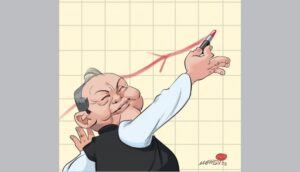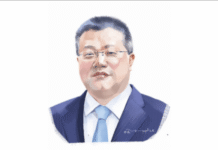 Abdul Bayes : THE commerce minister, Tipu Munshi, made a very ‘comical’ comment regarding the economic condition of people in his constituency, possibly extrapolating it for the whole country. He said that (even with the heat of inflation over the head), women in his area are using lipstick a few times a day, implying perhaps that economic conditions in Bangladesh are not as bad as critics insist. The minister also proudly propagated that people are changing sandals off and on in his constituency.
Abdul Bayes : THE commerce minister, Tipu Munshi, made a very ‘comical’ comment regarding the economic condition of people in his constituency, possibly extrapolating it for the whole country. He said that (even with the heat of inflation over the head), women in his area are using lipstick a few times a day, implying perhaps that economic conditions in Bangladesh are not as bad as critics insist. The minister also proudly propagated that people are changing sandals off and on in his constituency.
This may be the case in his constituency, where people’s income increased to the extent that they could change sandals whenever they could. But while teaching the effects of inflation in universities, we often come across a concept called the shoe leather cost of inflation. The concept of shoe-leather costs, ‘essentially, refers to the time and effort people take to minimise the effect of inflation on the eroding purchasing power of money. People wear out their shoes on the way back and forth to the bank, so to speak, trying to protect the value of their assets.’
But available studies point to the purchase of lipstick as signaling an economic downturn as well. There is a famous ‘lipstick effect’ theory, more often cited in developed countries. The theory is also part of the discussion in my class on managerial economics at East West University. The term lipstick effect was coined by Leonard Lauder, a former Estée Lauder chairperson. After the September 11 attack in the United States, Lauder is reported to have noticed that his company still managed to sell lipstick more than usual. His realisation is that women resolved to buy products like lipstick in place of other costly luxury items. Lauder then concluded that lipstick, with its higher income elasticity, is a contrary indicator of an economy. But a conclusion on that causal relation requires a more rigorous econometric analysis that might have been missed out on in Lauder’s thesis.
However, ‘the lipstick effect describes the observation that consumers will still tend to buy small luxury items even during an economic downturn; cash-strapped consumers want to treat themselves to something that lets them forget their financial problems.’
By and large, as the theory of the lipstick effect postulates, sales of small luxury items can be used as an indicator of economic recessions based on the lipstick effect. In Bangladesh, perhaps we can coin ‘the mobile phone effect’ arguing that despite all economic odds around, people seem to use more mobile phones to maintain the status quo.
The lipstick or mobile phone effect is a manifestation of something that economists call the income effect when they ‘break down consumer demand for any given product as a combination of the effects of the price of a good relative to other goods, known as the substitution effect, and the consumer’s income, known as the income effect.’
For normal goods, as a consumer’s income rises, so does demand for the particular commodity. However, for some goods, known as inferior goods, rising consumer income actually weakens demand, and vice versa. Coarse rice and coarse cloth in Bangladesh are classic examples of inferior goods. ‘This is what occurs in the case of the lipstick effect. As consumers’ incomes fall, they will forgo big-ticket luxury goods purchases that they can no longer afford and instead spend their (reduced) discretionary income on smaller luxury items.’
On the other hand, as one would argue, the lipstick effect is one of the reasons that fast-casual restaurants and movie complexes typically do well amid recessions. Cash-strapped consumers want to treat themselves to something that lets them forget their financial problems. When they can’t afford to escape to attend wedding ceremonies, they will settle for a fairly cheap night out and a movie, adjusting their budget accordingly.
‘Another theoretical basis for the lipstick effect is that during times of economic recession, labour markets become more competitive. This can lead job seekers to spend more on goods that enhance their perceived advantages over other candidate employees in order to get or keep a job. Paying more attention to the visible aspects of one’s job market appeal by using more or better cosmetics can be one way of doing this.’
There is another nice story on economic forecasting. Former Federal Reserve head and a truly famous central banker, Alan Greenspan, once invoked a keen interest in men’s underwear ‘not because he’s preoccupied with the evolving fashions of nether garments, but rather because he sees underwear sales as a key economic predictor… It may sound weird, but ‘it’s just one of the many strange ways experts try to predict booms and busts‘.
The main point is that those sales are usually stable, ‘so on those few occasions where they dip, that means that men are so pinched that they are deciding not to replace underpants’, says Greenspan.
The men’s underwear index backs up Greenspan’s theory: US sales of men’s underwear fell significantly from 2007 to 2009, during the Great Recession, but gained steam again in 2010 as the economy recovered.
‘Analysts are always searching for signs that might predict a downturn. Just as a stampede of animals fleeing to higher ground can be an early sign of a tsunami, the same rules can be applied to the state of the economy.’
Now, the commerce minister’s comment on buying lipstick, which has both an income and substitution effect. But we firmly believe that, till now, it is not an indicator of an economic recession in Bangladesh. But obviously, as said earlier, shoe-leather costs refer to the time and effort people take to minimise the effect of inflation on the eroding purchasing power of money. People wear out their shoes on the way back and forth to the bank, so to speak, trying to protect the value of their assets. The underwear hypothesis could be tested another time.
Abdul Bayes, a former professor of economics and vice-chancellor, Jahangirnagar University, is now an adjunct faculty at East West University.
New Agw









